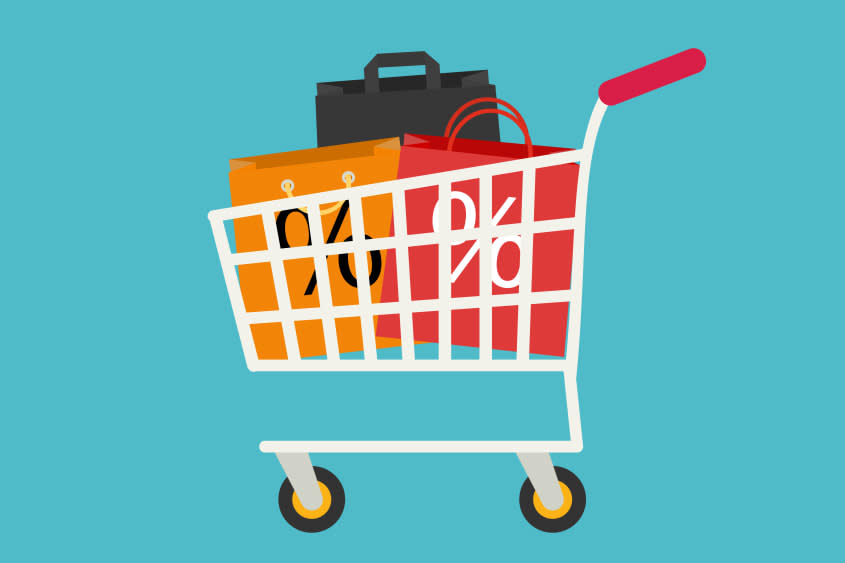5 psychological tricks companies use to make you spend more

There's nothing worse than thinking you're getting a good deal, only to realize you were duped. Of course, stores are in the business of trying to make money, but that doesn't mean consumers can't get wise to their tricks and avoid being swept up in what's essentially just good marketing.
Stores are "a lot like magicians," said U.S. News & World Report. They use psychology to "get money to disappear from customers' bank accounts and wallets." Here are some of the most common tactics to watch for.
1. Strategic product placement
Stores — either brick-and-mortar or online — don't just haphazardly throw items up on their shelves or websites. Rather, items are placed very strategically, often to make customers think they're getting a better deal.
One tactic is known as "the compromise price effect," said GoBankingRates. This is whe "a store will place an expensive item right next to a slightly cheaper, but comparable item." When they pick up the cheaper option, they'll feel like they got a deal. But the bad news is that really, "the retailer has usually inflated the price of the more expensive item to give the illusion that the cheaper item is discounted," The Motley Fool said.
Another tactic is "decoy pricing," said U.S. News & World Report. This practice is particularly popular when it comes to software and membership pricing. "This involves setting up your tiers so that one option — usually the middle one — seems like a much better deal. This can encourage customers to choose a more expensive option than they might have otherwise," Danielle Fitzpatrick Clark, CEO and founder of marketing firm Influence Builder, told U.S. News & World Report.
2. Dropping the dollar sign
The human mind is a funny thing: If we don't see a dollar sign listed, then we are likely to spend more, said U.S. News & World Report, citing research from Cornell University. Indeed, something as simple as a meal at a restaurant being listed as 25, rather than $25, can affect how much we're willing to spend. Per the Cornell study, "a format that leaves off dollar signs and even the word dollar gets people to spend 8% more at restaurants," said Money.com.
3. Price tags ending in '9' (or .95)
Even if we've heard about this trick before, we still fall for it. "New York University did a study to see if an item priced at $4.99 really makes a difference in a customer's purchase decision compared to something that is priced at $5.00 flat, and it absolutely does," according to MoneyWise. It works with bigger numbers too: U.S. News & World Report cited field studies by the journal Quantitative Marketing and Economics that found that "when a consumer was offered the choice to buy similar merchandise — like a $49 dress versus a $44 dress — more people would purchase the item that ended in nine."
There's also another tactic some restaurants are using, which is listening prices that end in .95. A menu engineer dubbed these numbers "friendlier than those ending in .99, which are associated with value and cheapness," according to U.S. News & World Report.
4. Deceptively advertised 'up to' sales
Stores will take advantage of our tendency to overlook the fine print with the classic "up to" sale. It's easy to see why a sign advertising 50% off might lure you into a store, but all too commonly, when you walk in, you'll "notice the fine print, and it actually says 'up to 50% off,' meaning an item can be discounted by any amount between 1% and 50%," explained U.S. News & World Report.
And in some cases, you might not even really notice the fine print (or the numbers). This can lead you to shop what you think is a really good sale chock-full of half-off items, when in reality, it might be only a select few items on deep discount.
5. Bulk 'bargains'
While sometimes you can get a deal if you bundle services or buy in bulk, this isn't always the case — and sometimes it can lead to overspending and buying more than you actually need. For instance, you often see cable, insurance, and streaming companies allowing you to roll a few services into one price at a little bit of a discount. But companies aren't being generous by doing this, they just "know that customers or clients might be tempted to spend more upfront to save in the long run," Fitzpatrick Clark told U.S. News & World Report.
This principle can also apply to buying in bulk, according to Money.com. One researcher found that "adding the sentence 'maximum 8 cans per customer' to the price tag of soup cans caused sales to jump, even if no true discount was offered, because it gave the illusion of one."
Becca Stanek has worked as an editor and writer in the personal finance space since 2017. She has previously served as the managing editor for investing and savings content at LendingTree, an editor at SmartAsset and a staff writer for The Week.
You may also like
Florida construction and agricultural workforces diminished after new immigration law takes effect
Judge limits how Biden officials can communicate with social media companies
How solar and wind energy are saving Texans from a record heatwave

